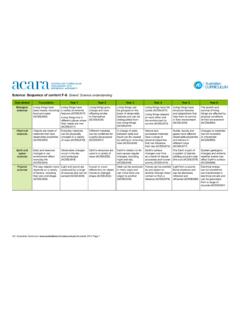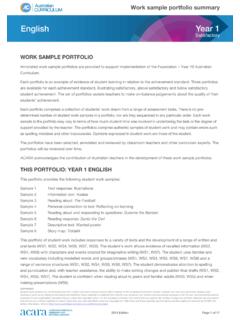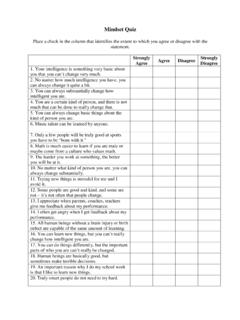Transcription of nglish Year 2 - Australian Curriculum, Assessment and ...
1 EnglishYear 2 Satisfactory2014 EditionPage 1 of 26 Work sample portfolio summaryWORK SAMPLE PORTFOLIOA nnotated work sample portfolios are provided to support implementation of the Foundation year 10 Australian portfolio is an example of evidence of student learning in relation to the achievement standard. Three portfolios are available for each achievement standard, illustrating satisfactory, above satisfactory and below satisfactory student achievement. The set of portfolios assists teachers to make on-balance judgements about the quality of their students portfolio comprises a collection of students work drawn from a range of Assessment tasks. There is no pre-determined number of student work samples in a portfolio, nor are they sequenced in any particular order. Each work sample in the portfolio may vary in terms of how much student time was involved in undertaking the task or the degree of support provided by the teacher.
2 The portfolios comprise authentic samples of student work and may contain errors such as spelling mistakes and other inaccuracies. Opinions expressed in student work are those of the portfolios have been selected, annotated and reviewed by classroom teachers and other curriculum experts. The portfolios will be reviewed over time. ACARA acknowledges the contribution of Australian teachers in the development of these work sample portfolios. THIS PORTFOLIO: year 2 ENGLISHThis portfolio provides the following student work samples: Sample 1 Text connection: The Deep Sample 2 character preference: Olga Sample 3 Written response: Comparing literary text Sample 4 Written report: Excursion to Kings Park Sample 5 Text response: Olga the Brolga Sample 6 Oral presentation: All about me Sample 7 Reading aloud: A Cure for Hiccups Sample 8 Imaginative text: The mad story about a pirate Sample 9 Group discussion: Creating a fairy story Sample 10 Descriptive poem: MixturesCOPYRIGHTS tudent work samples are not licensed under the creative commons license used for other material on the Australian Curriculum website.
3 Instead, you may view, download, display, print, reproduce (such as by making photocopies) and distribute these materials in unaltered form only for your personal, non-commercial educational purposes or for the non-commercial educational purposes of your organisation, provided that you retain this copyright notice. For the avoidance of doubt, this means that you cannot edit, modify or adapt any of these materials and you cannot sub-license any of these materials to others. Apart from any uses permitted under the Copyright Act 1968 (Cth), and those explicitly granted above, all other rights are reserved by ACARA. For further information, refer to ( ).EnglishYear 2 Satisfactory2014 EditionPage 2 of 26 Work sample portfolio summaryThis portfolio of student work includes responses to a variety of texts and the development of a range of written and oral texts.
4 The student uses a variety of text processing strategies to read (WS7), retrieve literal information, make inferences (WS1, WS2, WS3, WS5) and find the main idea in a text (WS1, WS2). The student creates written and multimodal texts for specific purposes and audiences (WS2, WS3, WS4, WS10) drawing on knowledge of grammar, vocabulary and punctuation (WS4, WS8, WS9, WS10). The student creates texts exploring sound and word patterns (WS10). The student demonstrates the ability to spell most high-frequency sight words and to use sound-letter knowledge to attempt new words (WS1, WS2, WS3, WS4, WS5, WS8 and WS10). COPYRIGHTS tudent work samples are not licensed under the creative commons license used for other material on the Australian Curriculum website. Instead, you may view, download, display, print, reproduce (such as by making photocopies) and distribute these materials in unaltered form only for your personal, non-commercial educational purposes or for the non-commercial educational purposes of your organisation, provided that you retain this copyright notice.
5 For the avoidance of doubt, this means that you cannot edit, modify or adapt any of these materials and you cannot sub-license any of these materials to others. Apart from any uses permitted under the Copyright Act 1968 (Cth), and those explicitly granted above, all other rights are reserved by ACARA. For further information, refer to ( ).EnglishYear 2 SatisfactoryWork sample 12014 EditionPage 3 of 26 Text connection: The DeepYear 2 English achievement standardThe parts of the achievement standard targeted in the Assessment task are modes (listening, reading and viewing)By the end of year 2, students understand how similar texts share characteristics by identifying text structures and language features used to describe characters, settings and read texts that contain varied sentence structures, some unfamiliar vocabulary, a significant number of high frequency sight words and images that provide additional information.
6 They monitor meaning and self-correct using context, prior knowledge, punctuation, language and phonic knowledge. They identify literal and implied meaning, main ideas and supporting detail. Students make connections between texts by comparing content. They listen for particular purposes. They listen for and manipulate sound combinations and rhythmic sound modes (speaking, writing and creating)When discussing their ideas and experiences, students use everyday language features and topic-specific vocabulary. They explain their preferences for aspects of texts using other texts as comparisons. They create texts that show how images support the meaning of the create texts, drawing on their own experiences, their imagination and information they have learned. They use a variety of strategies to engage in group and class discussions and make presentations.
7 They accurately spell familiar words and attempt to spell less familiar words and use punctuation accurately. They legibly write unjoined upper- and lower-case of taskAfter reading The Deep by Tim Winton, students were asked to consider how it connected with another text they had read. They were asked to: identify the key ideas in The Deep identify another text that connects with The Deep identify the connections between the two had previous lessons on making connections between texts. They had access to library resources and copies of The Deep to use as they sample 1 EnglishYear 2 Satisfactory2014 EditionPage 4 of 26 CopyrightStudent work samples are not licensed under the creative commons license used for other material on the Australian Curriculum website. Instead, a more restrictive licence applies.
8 For more information, please see the first page of this set of work samples and the copyright notice on the Australian Curriculum website ( ).AnnotationsResponds to questions and writes a brief summary describing the main ideas in a story read in accurate sentence boundary connections between two texts, by recognising that in both texts the characters link actions and feelings, for example, Alice wishing she could fly like a gull .Uses varied sentence structure to express and link ideas, for example, When Super Duck wakes up he wants to fly like Alice. Accurately spells high-frequency words, for example, little , does , while , and uses letter-sound knowledge to attempt unfamiliar words, for example, dolfin (dolphin).Reflects on the connection, making a comparison between characters actions, for example, The only different thing is that Super Duck flies and Alice does not.
9 Writes using legible unjoined upper- and lower-case connection: The DeepEnglishYear 2 Satisfactory2014 EditionPage 5 of 26 character preference: OlgaYear 2 English achievement standardThe parts of the achievement standard targeted in the Assessment task are modes (listening, reading and viewing)By the end of year 2, students understand how similar texts share characteristics by identifying text structures and language features used to describe characters, settings and read texts that contain varied sentence structures, some unfamiliar vocabulary, a significant number of high frequency sight words and images that provide additional information. They monitor meaning and self-correct using context, prior knowledge, punctuation, language and phonic knowledge. They identify literal and implied meaning, main ideas and supporting detail.
10 Students make connections between texts by comparing content. They listen for particular purposes. They listen for and manipulate sound combinations and rhythmic sound modes (speaking, writing and creating)When discussing their ideas and experiences, students use everyday language features and topic-specific vocabulary. They explain their preferences for aspects of texts using other texts as comparisons. They create texts that show how images support the meaning of the create texts, drawing on their own experiences, their imagination and information they have learned. They use a variety of strategies to engage in group and class discussions and make presentations. They accurately spell familiar words and attempt to spell less familiar words and use punctuation accurately. They legibly write unjoined upper- and lower-case of taskStudents read and discussed the texts Olga the Brolga by Rod Clement and Bernard the Brolga that Couldn t Dance by Denise Burt and Tom Bishop.










